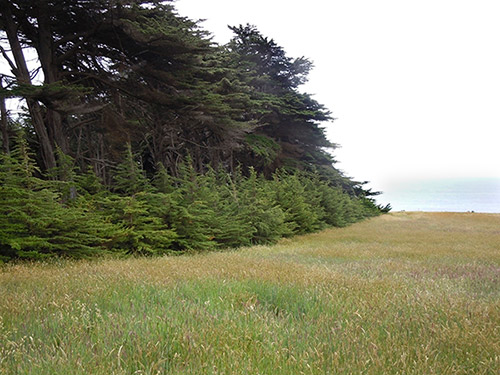Parabolic Windbreaks

Here, we see a new windbreak growing to replace the older, dying windbreak. Sea Ranch, CA. |
Curved, sexy shapes are the domain of racing cars, not for sculpting wind windbreaks.
Permaculture designs in the early books tended to have aesthetically-pleasing parabolic curves. This was a big fad for awhile. This recurring design element is, in my opinion, more an intellectual extraction than a literal element in the natural landscape.
In Permaculture - A Designer's Manual the only literal configuration for a windbreak is a crescent (a portion of a parabolic curve)—a curve elegantly extracted from earlier permaculture discourses on Golden spirals, smoke and water flow patterns, and eddy currents phenomena. This fixation on curved windbreaks ignores most of the published windbreak data and the extensive experience obtained during the establishment of windbreaks after the American dust bowl of the 1930s. As an example, from Plants, People, and Environmental Quality as long ago as 1972, we read “Studies have shown that shelterbelts and windbreaks are most effective when placed perpendicular (ed. emphasis) to the prevailing winds.” Shelterbelts wide swaths of trees best planted on farms. Windbreaks are one or two lines of trees that can be more appropriate for home landscapes.
Every windbreak generates turbulence at the ends of the windbreak. This turbulence back-eddies around the end of the windbreak, often at speeds up to 20% faster than the original wind speed. This is why the traditional recommendation has been that a windbreak should be 11.5 times wider than its mature height to leave a large, protected area on the leeward side of the windbreak which is unaffected by the turbulence at each end.
Permaculture, it seems, had chosen the mathematical form of a parabolic edge and then inferred the biological implications. While any curved line can lend artistic beauty to a design, it’s a stretch to say each curve represents an optimal biological design or that the ecological dynamic has been enhanced, especially in someone's backyard. What is presented here is an artful approach to design, but not one which necessarily enhances the ecology of the landscape. |

